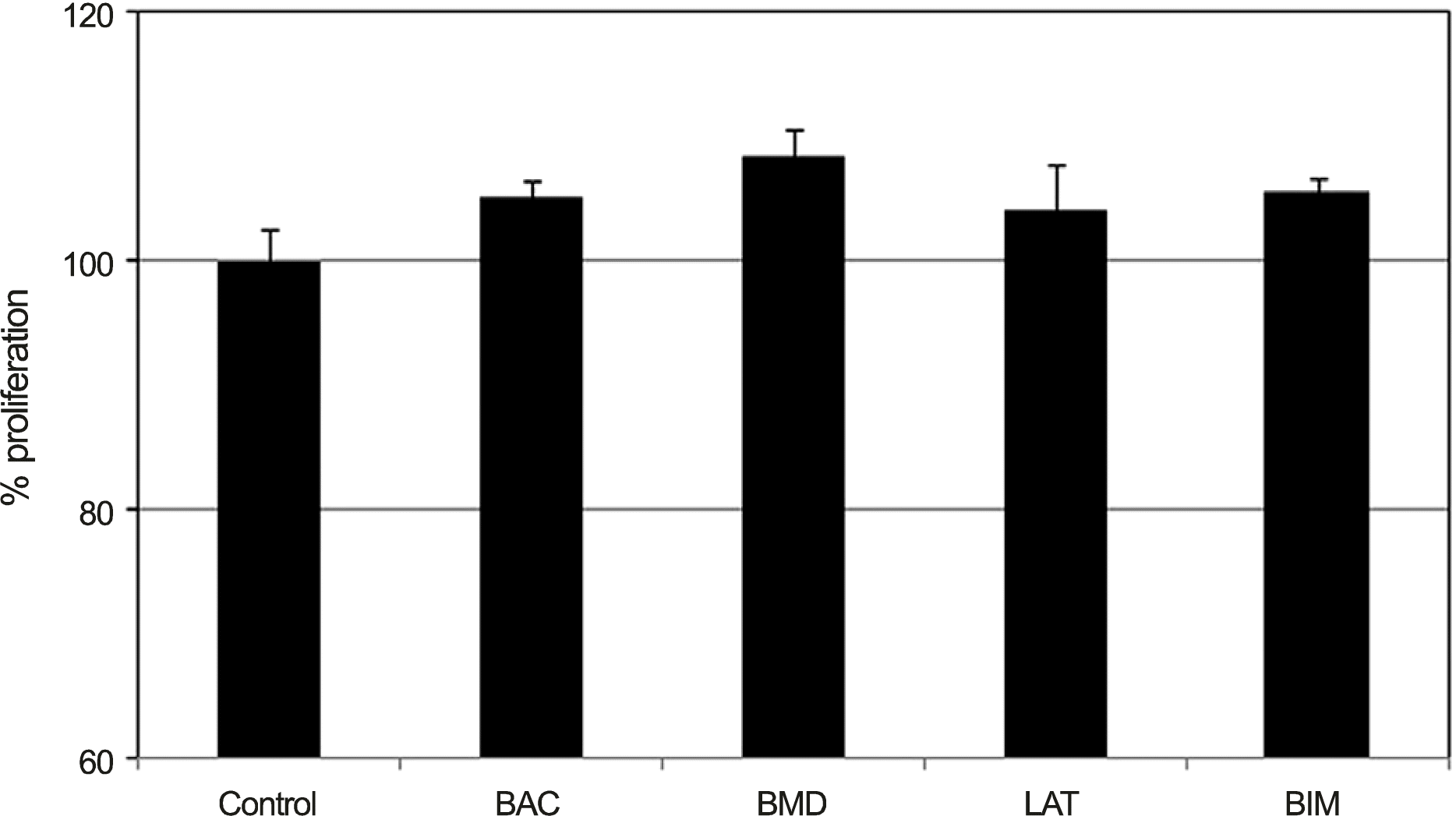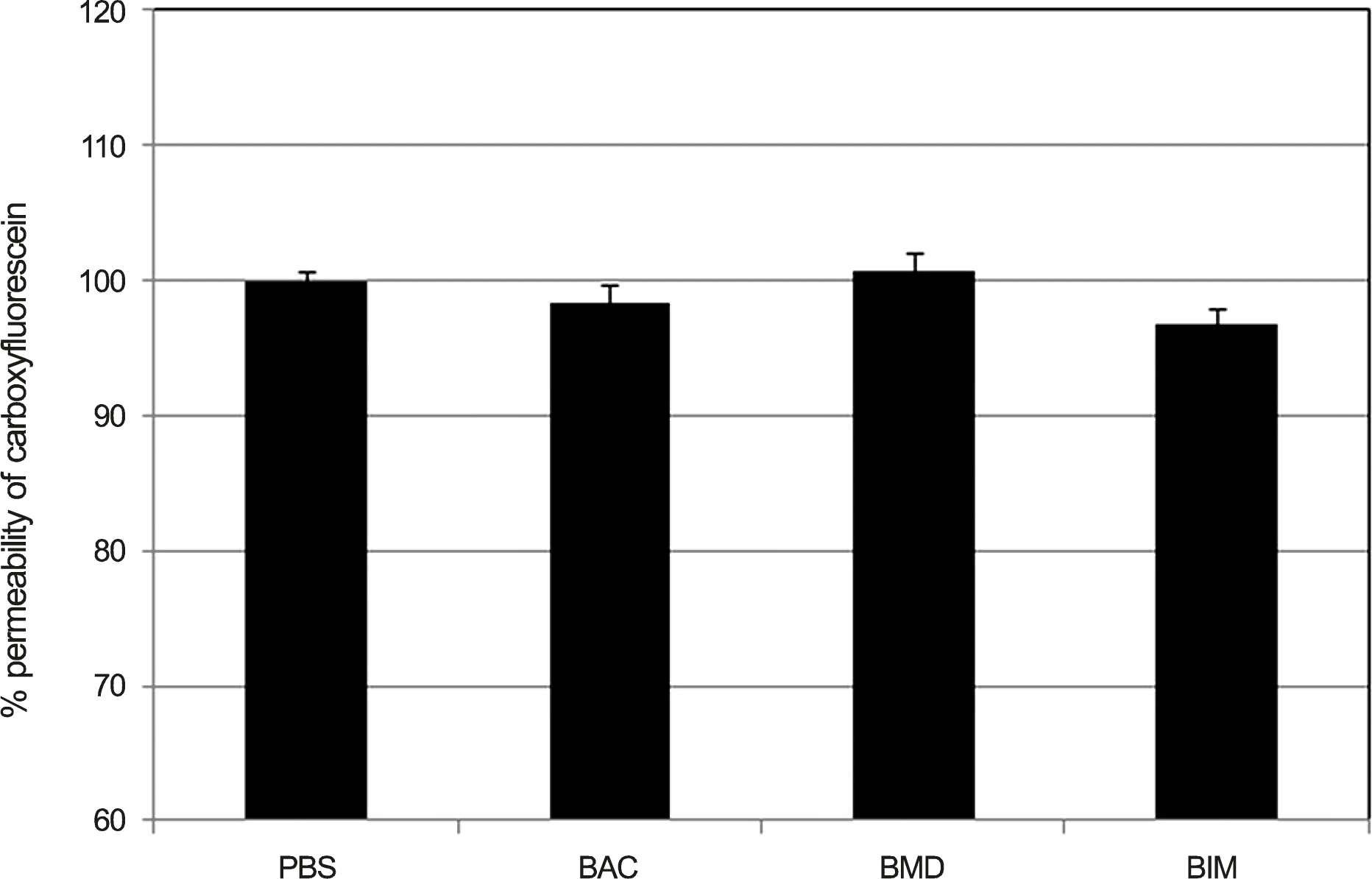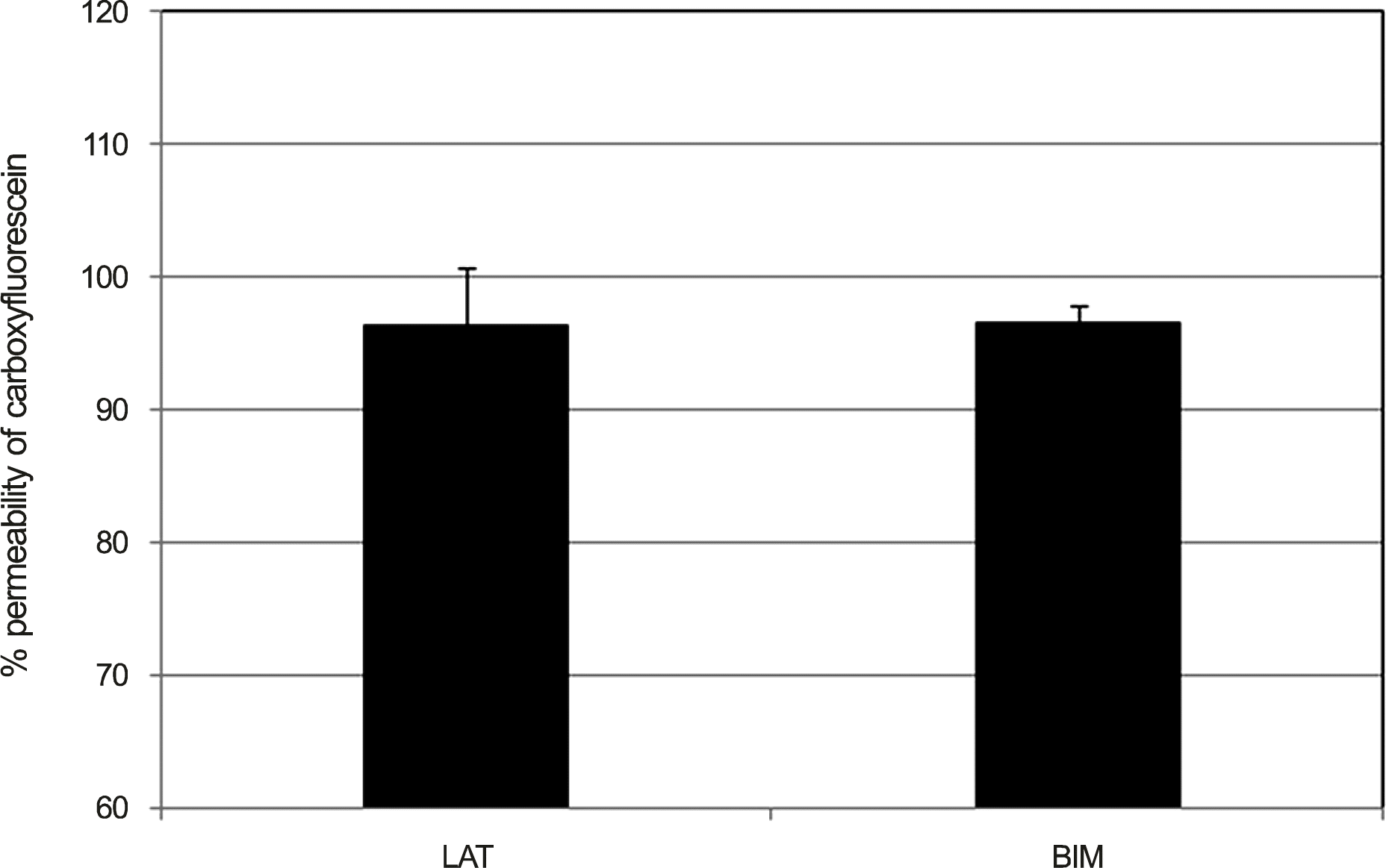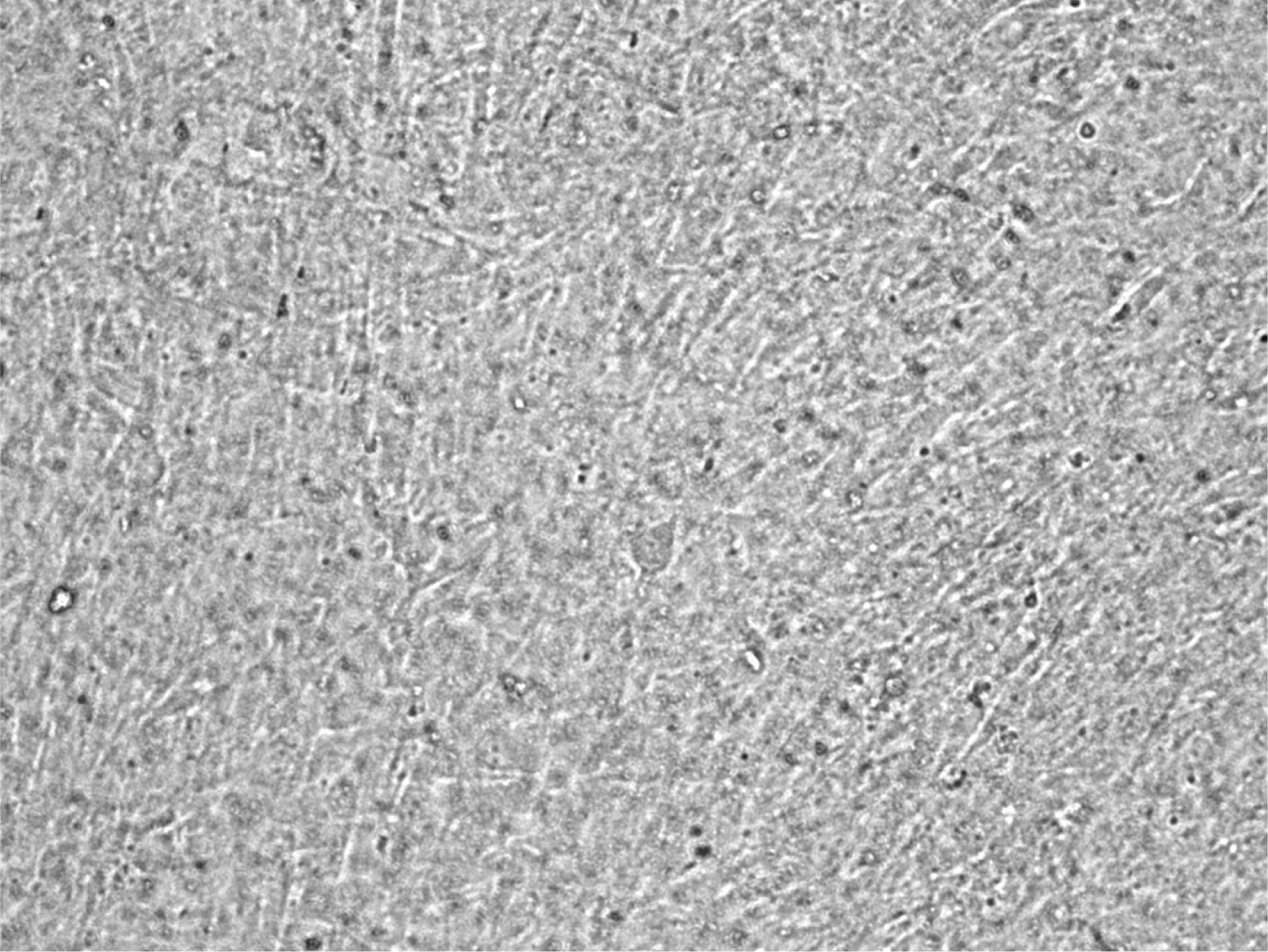초록
Purpose:
To investigate the effects of bimatoprost on the permeability of cultured human trabecular meshwork cells (HTMC) monolayer.
Methods:
HTMCs were cultured until confluency in the inner Transwell chamber and then exposed to benzalkonium chloride, bri-monidine, latanoprost or bimatoprost for 1 week. Carboxyfluorescein permeability through the HTMC monolayer was measured using a spectrofluorometer after 2 hours in the outer chamber. Cellular viability was assessed using the MTT assay.
Results:
Each drug diluted at 1/1000X did not affect the cellular survival ( p > 0.05). Brimonidine, latanoprost and bimatoprost did not affect the carboxyfluorescein permeability through the HTMC monolayer ( p > 0.05). The carboxyfluorescein permeability was not different between latanoptost and bimatoprost after 1 week of exposure ( p > 0.05).
Go to : 
References
1. Alvarado J, Murphy C, Juster R. Trabecular meshwork cellularity in primary open-angle glaucoma and nonglaucomatous normals. Ophthalmology. 1984; 91:564–79.

2. Rohen JW, Lütjen-Drecoll E, Flügel C, et al. Ultrastructure of the trabecular meshwork in untreated cases of primary open-angle glaucoma (POAG). Exp Eye Res. 1993; 56:683–92.
3. Stamer WD, Huang Y, Seftor RE, et al. Cultured human trabecular meshwork cells express functional alpha 2A adrenergic receptors. Invest Ophthalmol Vis Sci. 1996; 37:2426–33.
4. Toris CB, Gleason ML, Camras CB, Yablonski ME. Effects of bri-monidine on aqueous humor dynamics in human eyes. Arch Ophthalmol. 1995; 113:1514–7.

5. Winkler NS, Fautsch MP. Effects of prostaglandin analogues on aqueous humor outflow pathways. J Ocul Pharmacol Ther. 2014; 30:102–9.

6. Woodward DF, Liang Y, Krauss AH. Prostamides (prostaglandin-ethanolamides) and their pharmacology. Br J Pharmacol. 2008; 153:410–9.

7. Wan Z, Woodward DF, Cornell CL, et al. Bimatoprost, prostamide activity, and conventional drainage. Invest Ophthalmol Vis Sci. 2007; 48:4107–15.

8. Brubaker RF, Schoff EO, Nau CB, et al. Effects of AGN 192024, a new ocular hypotensive agent, on aqueous dynamics. Am J Ophthalmol. 2001; 131:19–24.
9. Grimes PA, Stone RA, Laties AM, Li W. Carboxyfluorescein. A probe of the blood-ocular barriers with lower membrane permeability than fluorescein. Arch Ophthalmol. 1982; 100:635–9.
10. Araie M. Carboxyfluorescein. A dye for evaluating the corneal endothelial barrier function in vivo. Exp Eye Res. 1986; 42:141–50.

11. Araie M. Barrier function of corneal endothelium and the intraocular irrigating solutions. Arch Ophthalmol. 1986; 104:435–8.

12. Tsuboi S, Pederson JE. Permeability of the isolated dog retinal pigment epithelium to carboxyfluorescein. Invest Ophthalmol Vis Sci. 1986; 27:1767–70.
13. Blair NP, Rusin MM. Blood-retinal barrier permeability to carboxyfluorescein and fluorescein in monkeys. Graefes Arch Clin Exp Ophthalmol. 1986; 224:419–22.

14. Grimes PA. Carboxyfluorescein transfer across the blood-retinal barrier evaluated by quantitative fluorescence microscopy: comparison with fluorescein. Exp Eye Res. 1988; 46:769–83.

15. Nakagawa S, Usui T, Yokoo S, et al. Toxicity evaluation of anti-glaucoma drugs using stratified human cultivated corneal epithelial sheets. Invest Ophthalmol Vis Sci. 2012; 53:5154–60.

16. Lei Y, Stamer WD, Wu J, Sun X. Oxidative stress impact on barrier function of porcine angular aqueous plexus cell monolayers. Invest Ophthalmol Vis Sci. 2013; 54:4827–35.

17. Burke AG, Zhou W, O'Brien ET, et al. Effect of hydrostatic pressure gradients and Na2EDTA on permeability of human Schlemm's canal cell monolayers. Curr Eye Res. 2004; 28:391–8.

18. Mosmann T. Rapid colorimetric assay for cellular growth and survival: application to proliferation and cytotoxicity assays. J Immunol Methods. 1983; 65:55–63.

19. Freimoser FM, Jakob CA, Aebi M, Tuor U. The MTT [3-(4,5-di-methylthiazol-2-yl)-2,5-diphenyltetrazolium bromide] assay is a fast and reliable method for colorimetric determination of fungal cell densities. Appl Environ Microbiol. 1999; 65:3727–9.

20. Crawford K, Kaufman PL, Gabelt BT. Effects of topical PGF2 alpha on aqueous humor dynamics in cynomolgus monkeys. Curr Eye Res. 1987; 6:1035–44.
21. Weinreb RN, Toris CB, Gabelt BT, et al. Effects of prostaglandins on the aqueous humor outflow pathways. Surv Ophthalmol. 2002; 47(Suppl 1):S53–64.

22. Lim KS, Nau CB, O'Byrne MM, et al. Mechanism of action of bimatoprost, latanoprost, and travoprost in healthy subjects. A cross-over study. Ophthalmology. 2008; 115:790–5.e4.
Go to : 
 | Figure 2.Effects of BAC, BMD, LAT and BIM on the survival of trabecular meshwork cells. Each drug did not decrease cellular viability significantly ( p > 0.05). BAC = benzalkonium chloride; BMD = brimonidine; LAT = latanoprost; BIM = bimatoprost. |
 | Figure 3.Effects of BAC, BMD, and BIM on the permeability of carboxyfluorescin through the trabecular meshwork cell monolayer. Each drug did not affect on the permeabilty of carboxyfluorescein significantly compared control using PBS ( p > 0.05). Carboxyfluorescein intensity of outer chamber normalized to the mean value obtained using PBS (permeability 100%). PBS = phosphate buffered saline; BAC = benzalkonium chloride; BMD = brimonidine; BIM = bimatoprost. |
 | Figure 4.Comparison of the permeability of carboxyfluorescin through the trabecular meshwork cell monolayer between LAT and BIM. There is no significant difference of the permeabilty of carboxyfluorescein between LAT and BIM ( p > 0.05). Carboxyfluorescein intensity of outer chamber normalized to the mean value obtained using PBS (permeability 100%). PBS = phosphate buffered saline; LAT = latanoprost; BIM = bimatoprost. |




 PDF
PDF ePub
ePub Citation
Citation Print
Print



 XML Download
XML Download